Big Data Application in Tourism: A Mobile Travel Agents Case
VerifiedAdded on 2022/10/04
|8
|1959
|18
Report
AI Summary
This report explores the application of big data analytics in the tourism sector, using Mobile Travel Agents as a case study. It begins by defining big data and its potential to solve business problems, especially in the tourism industry, which relies heavily on consumer preferences. The report analyzes Mobile Travel Agents' current analytics strategy, which is primarily based on website click data, and identifies churn rate as a key business initiative. It provides customer, product, and operational insights relevant to this initiative. The report then formulates descriptive, predictive, and prescriptive questions to address the churn rate issue. The recommended analytic strategy involves creating a database for data collection from customers, products, and operations. The data analysis approach includes both time series analysis and regression analysis to forecast churn rates and determine factors influencing them. The conclusion emphasizes that the application of these analytical techniques will help Mobile Travel Agents anticipate churn rates and develop targeted strategies to meet consumer needs and reduce churn.

Big Data
Paraphrase This Document
Need a fresh take? Get an instant paraphrase of this document with our AI Paraphraser
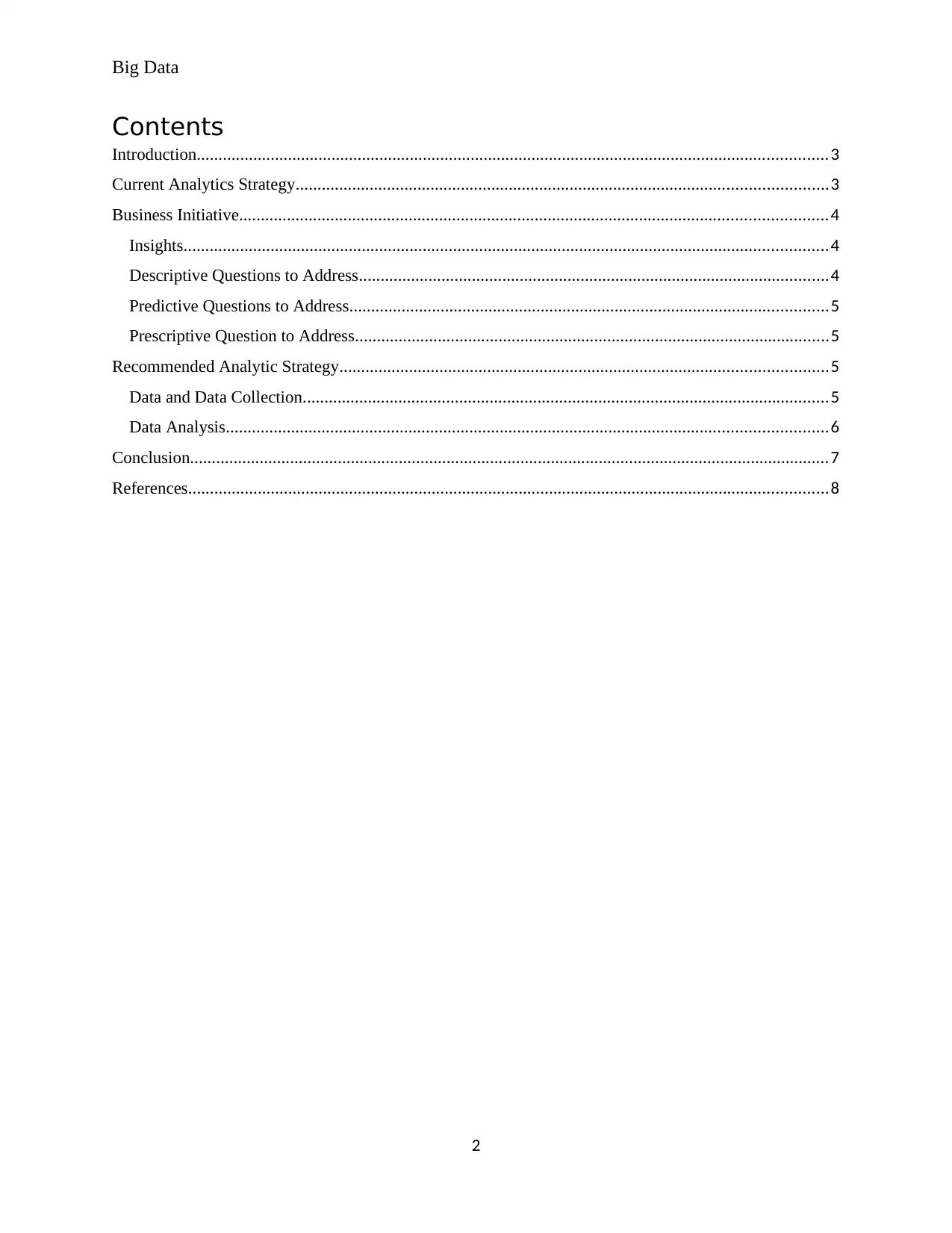
Big Data
Contents
Introduction.................................................................................................................................................3
Current Analytics Strategy..........................................................................................................................3
Business Initiative.......................................................................................................................................4
Insights....................................................................................................................................................4
Descriptive Questions to Address............................................................................................................4
Predictive Questions to Address..............................................................................................................5
Prescriptive Question to Address.............................................................................................................5
Recommended Analytic Strategy................................................................................................................5
Data and Data Collection.........................................................................................................................5
Data Analysis..........................................................................................................................................6
Conclusion...................................................................................................................................................7
References...................................................................................................................................................8
2
Contents
Introduction.................................................................................................................................................3
Current Analytics Strategy..........................................................................................................................3
Business Initiative.......................................................................................................................................4
Insights....................................................................................................................................................4
Descriptive Questions to Address............................................................................................................4
Predictive Questions to Address..............................................................................................................5
Prescriptive Question to Address.............................................................................................................5
Recommended Analytic Strategy................................................................................................................5
Data and Data Collection.........................................................................................................................5
Data Analysis..........................................................................................................................................6
Conclusion...................................................................................................................................................7
References...................................................................................................................................................8
2
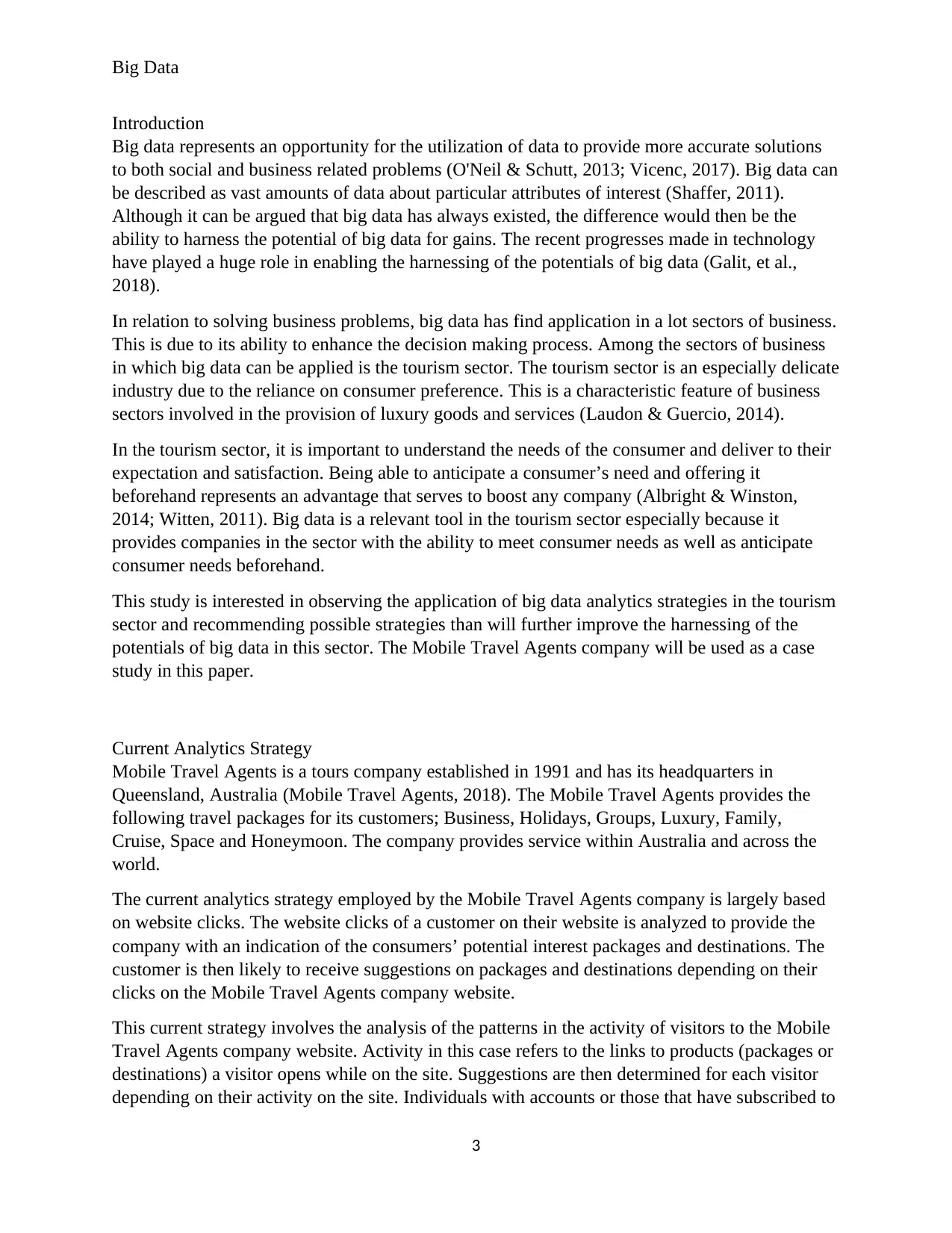
Big Data
Introduction
Big data represents an opportunity for the utilization of data to provide more accurate solutions
to both social and business related problems (O'Neil & Schutt, 2013; Vicenc, 2017). Big data can
be described as vast amounts of data about particular attributes of interest (Shaffer, 2011).
Although it can be argued that big data has always existed, the difference would then be the
ability to harness the potential of big data for gains. The recent progresses made in technology
have played a huge role in enabling the harnessing of the potentials of big data (Galit, et al.,
2018).
In relation to solving business problems, big data has find application in a lot sectors of business.
This is due to its ability to enhance the decision making process. Among the sectors of business
in which big data can be applied is the tourism sector. The tourism sector is an especially delicate
industry due to the reliance on consumer preference. This is a characteristic feature of business
sectors involved in the provision of luxury goods and services (Laudon & Guercio, 2014).
In the tourism sector, it is important to understand the needs of the consumer and deliver to their
expectation and satisfaction. Being able to anticipate a consumer’s need and offering it
beforehand represents an advantage that serves to boost any company (Albright & Winston,
2014; Witten, 2011). Big data is a relevant tool in the tourism sector especially because it
provides companies in the sector with the ability to meet consumer needs as well as anticipate
consumer needs beforehand.
This study is interested in observing the application of big data analytics strategies in the tourism
sector and recommending possible strategies than will further improve the harnessing of the
potentials of big data in this sector. The Mobile Travel Agents company will be used as a case
study in this paper.
Current Analytics Strategy
Mobile Travel Agents is a tours company established in 1991 and has its headquarters in
Queensland, Australia (Mobile Travel Agents, 2018). The Mobile Travel Agents provides the
following travel packages for its customers; Business, Holidays, Groups, Luxury, Family,
Cruise, Space and Honeymoon. The company provides service within Australia and across the
world.
The current analytics strategy employed by the Mobile Travel Agents company is largely based
on website clicks. The website clicks of a customer on their website is analyzed to provide the
company with an indication of the consumers’ potential interest packages and destinations. The
customer is then likely to receive suggestions on packages and destinations depending on their
clicks on the Mobile Travel Agents company website.
This current strategy involves the analysis of the patterns in the activity of visitors to the Mobile
Travel Agents company website. Activity in this case refers to the links to products (packages or
destinations) a visitor opens while on the site. Suggestions are then determined for each visitor
depending on their activity on the site. Individuals with accounts or those that have subscribed to
3
Introduction
Big data represents an opportunity for the utilization of data to provide more accurate solutions
to both social and business related problems (O'Neil & Schutt, 2013; Vicenc, 2017). Big data can
be described as vast amounts of data about particular attributes of interest (Shaffer, 2011).
Although it can be argued that big data has always existed, the difference would then be the
ability to harness the potential of big data for gains. The recent progresses made in technology
have played a huge role in enabling the harnessing of the potentials of big data (Galit, et al.,
2018).
In relation to solving business problems, big data has find application in a lot sectors of business.
This is due to its ability to enhance the decision making process. Among the sectors of business
in which big data can be applied is the tourism sector. The tourism sector is an especially delicate
industry due to the reliance on consumer preference. This is a characteristic feature of business
sectors involved in the provision of luxury goods and services (Laudon & Guercio, 2014).
In the tourism sector, it is important to understand the needs of the consumer and deliver to their
expectation and satisfaction. Being able to anticipate a consumer’s need and offering it
beforehand represents an advantage that serves to boost any company (Albright & Winston,
2014; Witten, 2011). Big data is a relevant tool in the tourism sector especially because it
provides companies in the sector with the ability to meet consumer needs as well as anticipate
consumer needs beforehand.
This study is interested in observing the application of big data analytics strategies in the tourism
sector and recommending possible strategies than will further improve the harnessing of the
potentials of big data in this sector. The Mobile Travel Agents company will be used as a case
study in this paper.
Current Analytics Strategy
Mobile Travel Agents is a tours company established in 1991 and has its headquarters in
Queensland, Australia (Mobile Travel Agents, 2018). The Mobile Travel Agents provides the
following travel packages for its customers; Business, Holidays, Groups, Luxury, Family,
Cruise, Space and Honeymoon. The company provides service within Australia and across the
world.
The current analytics strategy employed by the Mobile Travel Agents company is largely based
on website clicks. The website clicks of a customer on their website is analyzed to provide the
company with an indication of the consumers’ potential interest packages and destinations. The
customer is then likely to receive suggestions on packages and destinations depending on their
clicks on the Mobile Travel Agents company website.
This current strategy involves the analysis of the patterns in the activity of visitors to the Mobile
Travel Agents company website. Activity in this case refers to the links to products (packages or
destinations) a visitor opens while on the site. Suggestions are then determined for each visitor
depending on their activity on the site. Individuals with accounts or those that have subscribed to
3
⊘ This is a preview!⊘
Do you want full access?
Subscribe today to unlock all pages.

Trusted by 1+ million students worldwide
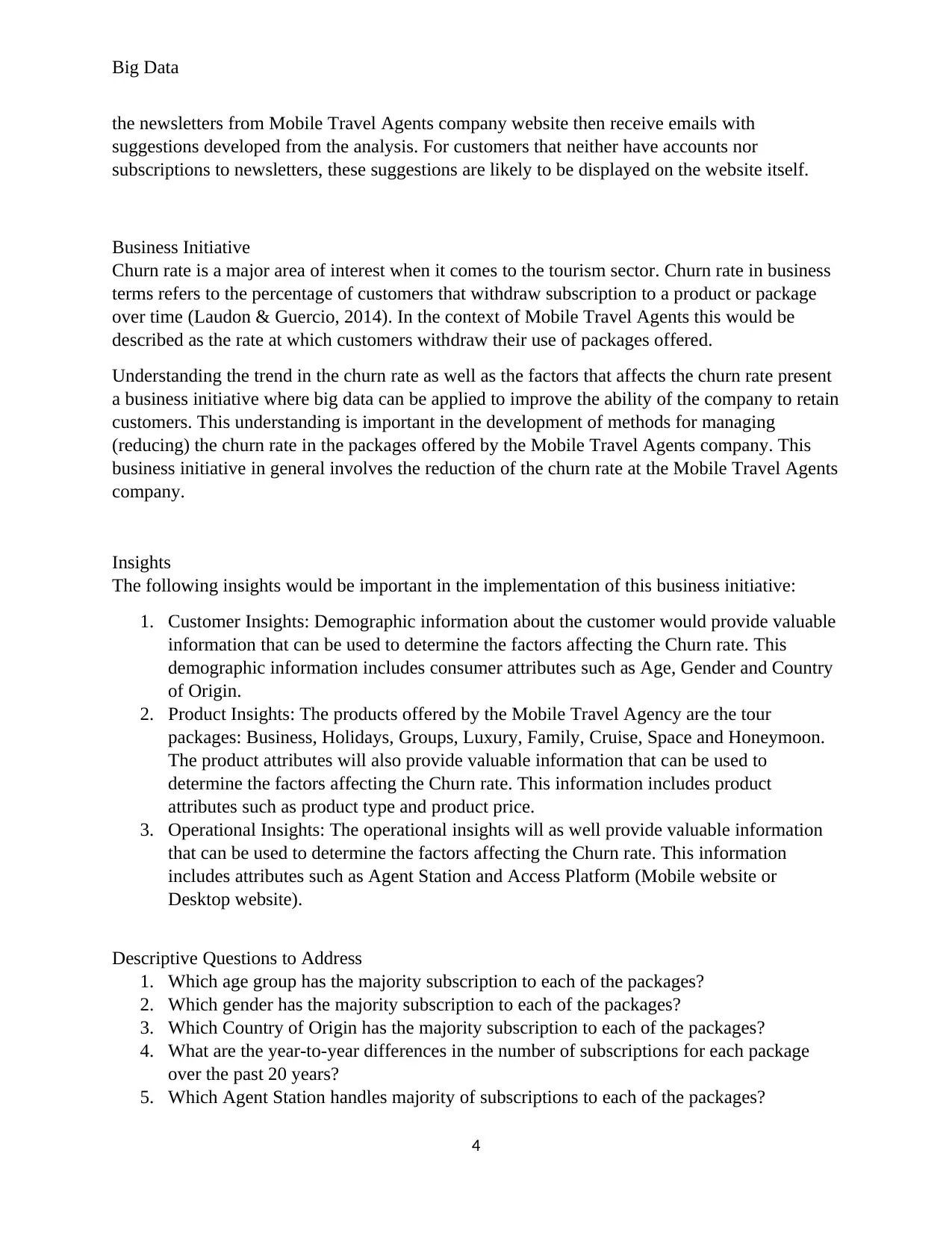
Big Data
the newsletters from Mobile Travel Agents company website then receive emails with
suggestions developed from the analysis. For customers that neither have accounts nor
subscriptions to newsletters, these suggestions are likely to be displayed on the website itself.
Business Initiative
Churn rate is a major area of interest when it comes to the tourism sector. Churn rate in business
terms refers to the percentage of customers that withdraw subscription to a product or package
over time (Laudon & Guercio, 2014). In the context of Mobile Travel Agents this would be
described as the rate at which customers withdraw their use of packages offered.
Understanding the trend in the churn rate as well as the factors that affects the churn rate present
a business initiative where big data can be applied to improve the ability of the company to retain
customers. This understanding is important in the development of methods for managing
(reducing) the churn rate in the packages offered by the Mobile Travel Agents company. This
business initiative in general involves the reduction of the churn rate at the Mobile Travel Agents
company.
Insights
The following insights would be important in the implementation of this business initiative:
1. Customer Insights: Demographic information about the customer would provide valuable
information that can be used to determine the factors affecting the Churn rate. This
demographic information includes consumer attributes such as Age, Gender and Country
of Origin.
2. Product Insights: The products offered by the Mobile Travel Agency are the tour
packages: Business, Holidays, Groups, Luxury, Family, Cruise, Space and Honeymoon.
The product attributes will also provide valuable information that can be used to
determine the factors affecting the Churn rate. This information includes product
attributes such as product type and product price.
3. Operational Insights: The operational insights will as well provide valuable information
that can be used to determine the factors affecting the Churn rate. This information
includes attributes such as Agent Station and Access Platform (Mobile website or
Desktop website).
Descriptive Questions to Address
1. Which age group has the majority subscription to each of the packages?
2. Which gender has the majority subscription to each of the packages?
3. Which Country of Origin has the majority subscription to each of the packages?
4. What are the year-to-year differences in the number of subscriptions for each package
over the past 20 years?
5. Which Agent Station handles majority of subscriptions to each of the packages?
4
the newsletters from Mobile Travel Agents company website then receive emails with
suggestions developed from the analysis. For customers that neither have accounts nor
subscriptions to newsletters, these suggestions are likely to be displayed on the website itself.
Business Initiative
Churn rate is a major area of interest when it comes to the tourism sector. Churn rate in business
terms refers to the percentage of customers that withdraw subscription to a product or package
over time (Laudon & Guercio, 2014). In the context of Mobile Travel Agents this would be
described as the rate at which customers withdraw their use of packages offered.
Understanding the trend in the churn rate as well as the factors that affects the churn rate present
a business initiative where big data can be applied to improve the ability of the company to retain
customers. This understanding is important in the development of methods for managing
(reducing) the churn rate in the packages offered by the Mobile Travel Agents company. This
business initiative in general involves the reduction of the churn rate at the Mobile Travel Agents
company.
Insights
The following insights would be important in the implementation of this business initiative:
1. Customer Insights: Demographic information about the customer would provide valuable
information that can be used to determine the factors affecting the Churn rate. This
demographic information includes consumer attributes such as Age, Gender and Country
of Origin.
2. Product Insights: The products offered by the Mobile Travel Agency are the tour
packages: Business, Holidays, Groups, Luxury, Family, Cruise, Space and Honeymoon.
The product attributes will also provide valuable information that can be used to
determine the factors affecting the Churn rate. This information includes product
attributes such as product type and product price.
3. Operational Insights: The operational insights will as well provide valuable information
that can be used to determine the factors affecting the Churn rate. This information
includes attributes such as Agent Station and Access Platform (Mobile website or
Desktop website).
Descriptive Questions to Address
1. Which age group has the majority subscription to each of the packages?
2. Which gender has the majority subscription to each of the packages?
3. Which Country of Origin has the majority subscription to each of the packages?
4. What are the year-to-year differences in the number of subscriptions for each package
over the past 20 years?
5. Which Agent Station handles majority of subscriptions to each of the packages?
4
Paraphrase This Document
Need a fresh take? Get an instant paraphrase of this document with our AI Paraphraser
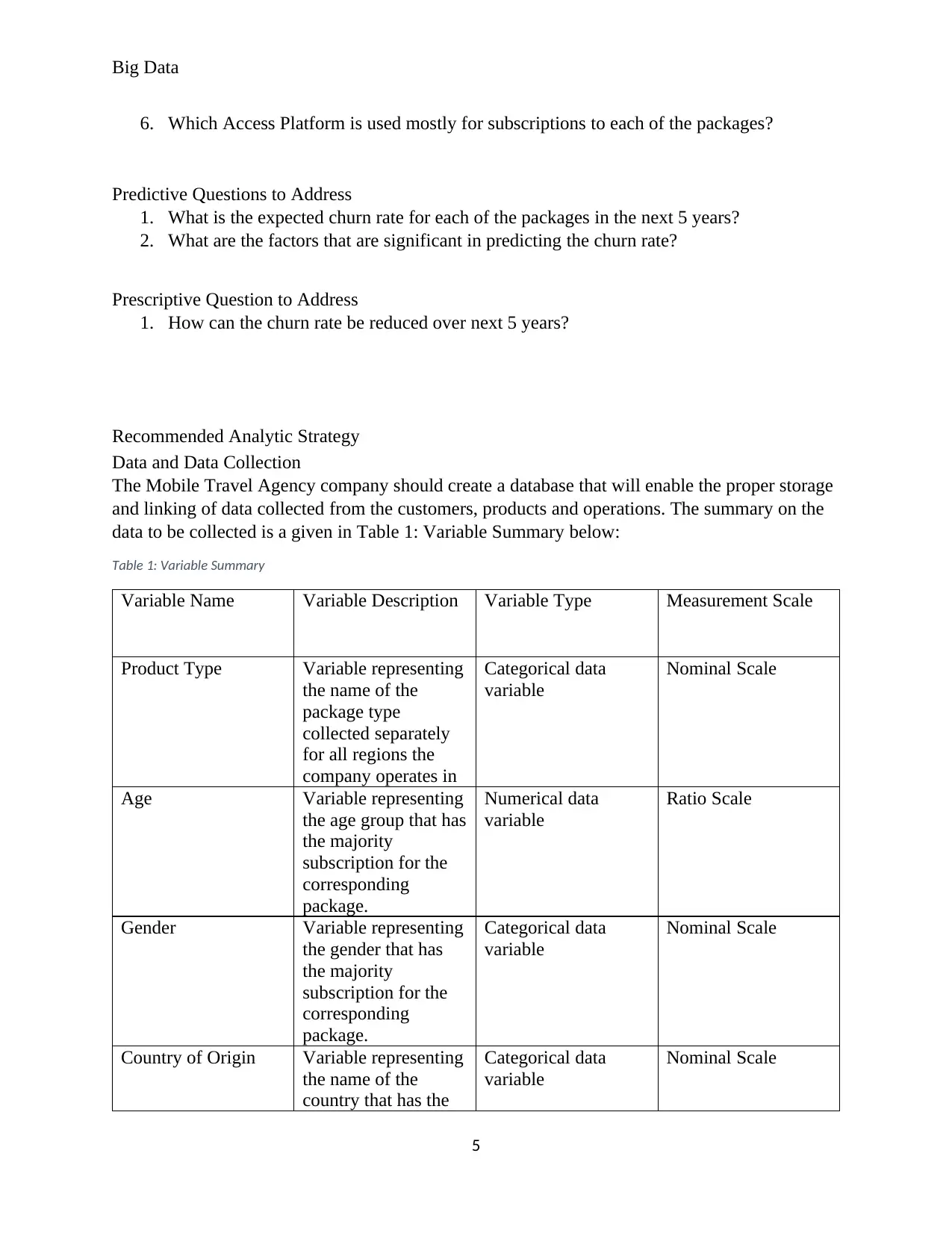
Big Data
6. Which Access Platform is used mostly for subscriptions to each of the packages?
Predictive Questions to Address
1. What is the expected churn rate for each of the packages in the next 5 years?
2. What are the factors that are significant in predicting the churn rate?
Prescriptive Question to Address
1. How can the churn rate be reduced over next 5 years?
Recommended Analytic Strategy
Data and Data Collection
The Mobile Travel Agency company should create a database that will enable the proper storage
and linking of data collected from the customers, products and operations. The summary on the
data to be collected is a given in Table 1: Variable Summary below:
Table 1: Variable Summary
Variable Name Variable Description Variable Type Measurement Scale
Product Type Variable representing
the name of the
package type
collected separately
for all regions the
company operates in
Categorical data
variable
Nominal Scale
Age Variable representing
the age group that has
the majority
subscription for the
corresponding
package.
Numerical data
variable
Ratio Scale
Gender Variable representing
the gender that has
the majority
subscription for the
corresponding
package.
Categorical data
variable
Nominal Scale
Country of Origin Variable representing
the name of the
country that has the
Categorical data
variable
Nominal Scale
5
6. Which Access Platform is used mostly for subscriptions to each of the packages?
Predictive Questions to Address
1. What is the expected churn rate for each of the packages in the next 5 years?
2. What are the factors that are significant in predicting the churn rate?
Prescriptive Question to Address
1. How can the churn rate be reduced over next 5 years?
Recommended Analytic Strategy
Data and Data Collection
The Mobile Travel Agency company should create a database that will enable the proper storage
and linking of data collected from the customers, products and operations. The summary on the
data to be collected is a given in Table 1: Variable Summary below:
Table 1: Variable Summary
Variable Name Variable Description Variable Type Measurement Scale
Product Type Variable representing
the name of the
package type
collected separately
for all regions the
company operates in
Categorical data
variable
Nominal Scale
Age Variable representing
the age group that has
the majority
subscription for the
corresponding
package.
Numerical data
variable
Ratio Scale
Gender Variable representing
the gender that has
the majority
subscription for the
corresponding
package.
Categorical data
variable
Nominal Scale
Country of Origin Variable representing
the name of the
country that has the
Categorical data
variable
Nominal Scale
5
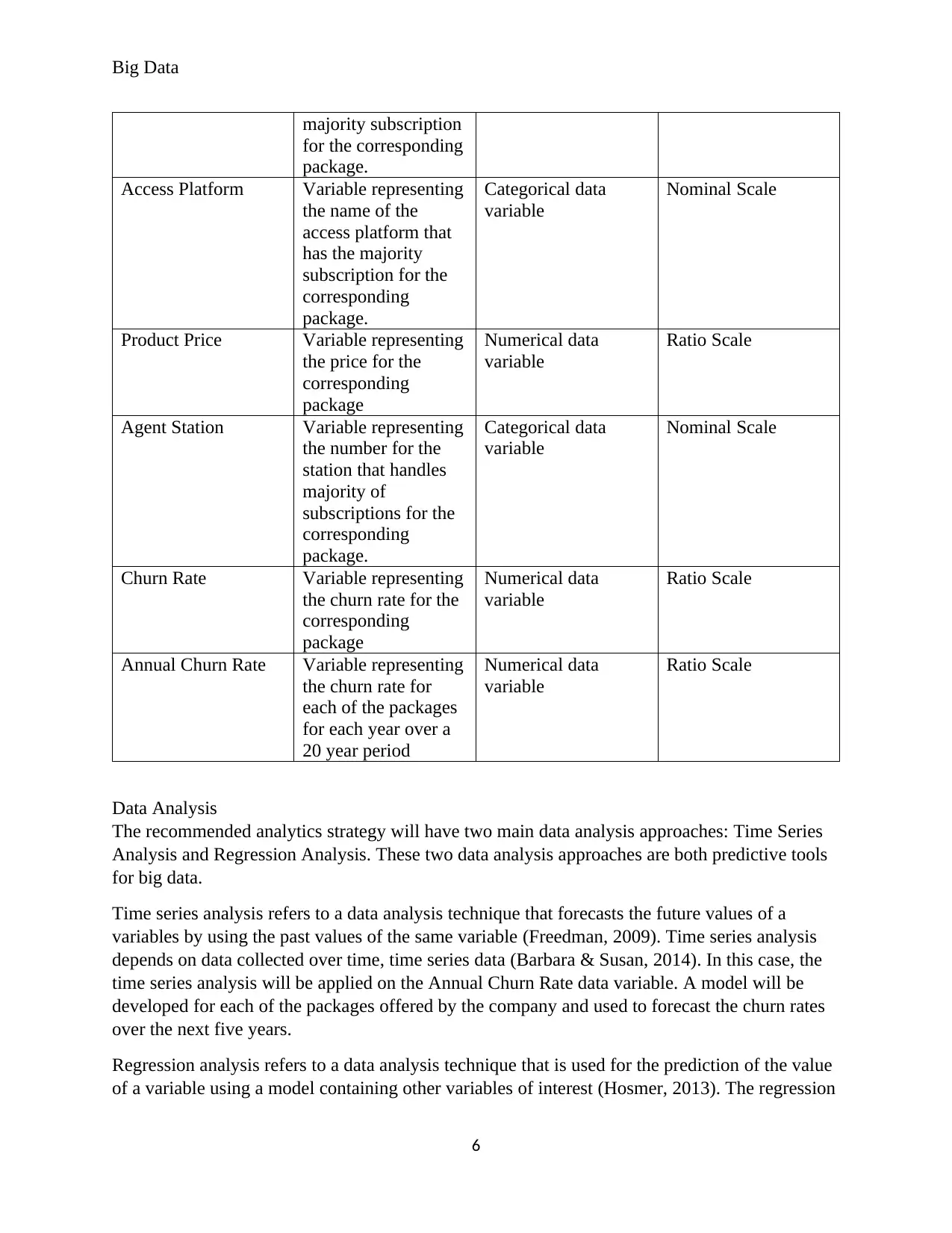
Big Data
majority subscription
for the corresponding
package.
Access Platform Variable representing
the name of the
access platform that
has the majority
subscription for the
corresponding
package.
Categorical data
variable
Nominal Scale
Product Price Variable representing
the price for the
corresponding
package
Numerical data
variable
Ratio Scale
Agent Station Variable representing
the number for the
station that handles
majority of
subscriptions for the
corresponding
package.
Categorical data
variable
Nominal Scale
Churn Rate Variable representing
the churn rate for the
corresponding
package
Numerical data
variable
Ratio Scale
Annual Churn Rate Variable representing
the churn rate for
each of the packages
for each year over a
20 year period
Numerical data
variable
Ratio Scale
Data Analysis
The recommended analytics strategy will have two main data analysis approaches: Time Series
Analysis and Regression Analysis. These two data analysis approaches are both predictive tools
for big data.
Time series analysis refers to a data analysis technique that forecasts the future values of a
variables by using the past values of the same variable (Freedman, 2009). Time series analysis
depends on data collected over time, time series data (Barbara & Susan, 2014). In this case, the
time series analysis will be applied on the Annual Churn Rate data variable. A model will be
developed for each of the packages offered by the company and used to forecast the churn rates
over the next five years.
Regression analysis refers to a data analysis technique that is used for the prediction of the value
of a variable using a model containing other variables of interest (Hosmer, 2013). The regression
6
majority subscription
for the corresponding
package.
Access Platform Variable representing
the name of the
access platform that
has the majority
subscription for the
corresponding
package.
Categorical data
variable
Nominal Scale
Product Price Variable representing
the price for the
corresponding
package
Numerical data
variable
Ratio Scale
Agent Station Variable representing
the number for the
station that handles
majority of
subscriptions for the
corresponding
package.
Categorical data
variable
Nominal Scale
Churn Rate Variable representing
the churn rate for the
corresponding
package
Numerical data
variable
Ratio Scale
Annual Churn Rate Variable representing
the churn rate for
each of the packages
for each year over a
20 year period
Numerical data
variable
Ratio Scale
Data Analysis
The recommended analytics strategy will have two main data analysis approaches: Time Series
Analysis and Regression Analysis. These two data analysis approaches are both predictive tools
for big data.
Time series analysis refers to a data analysis technique that forecasts the future values of a
variables by using the past values of the same variable (Freedman, 2009). Time series analysis
depends on data collected over time, time series data (Barbara & Susan, 2014). In this case, the
time series analysis will be applied on the Annual Churn Rate data variable. A model will be
developed for each of the packages offered by the company and used to forecast the churn rates
over the next five years.
Regression analysis refers to a data analysis technique that is used for the prediction of the value
of a variable using a model containing other variables of interest (Hosmer, 2013). The regression
6
⊘ This is a preview!⊘
Do you want full access?
Subscribe today to unlock all pages.

Trusted by 1+ million students worldwide
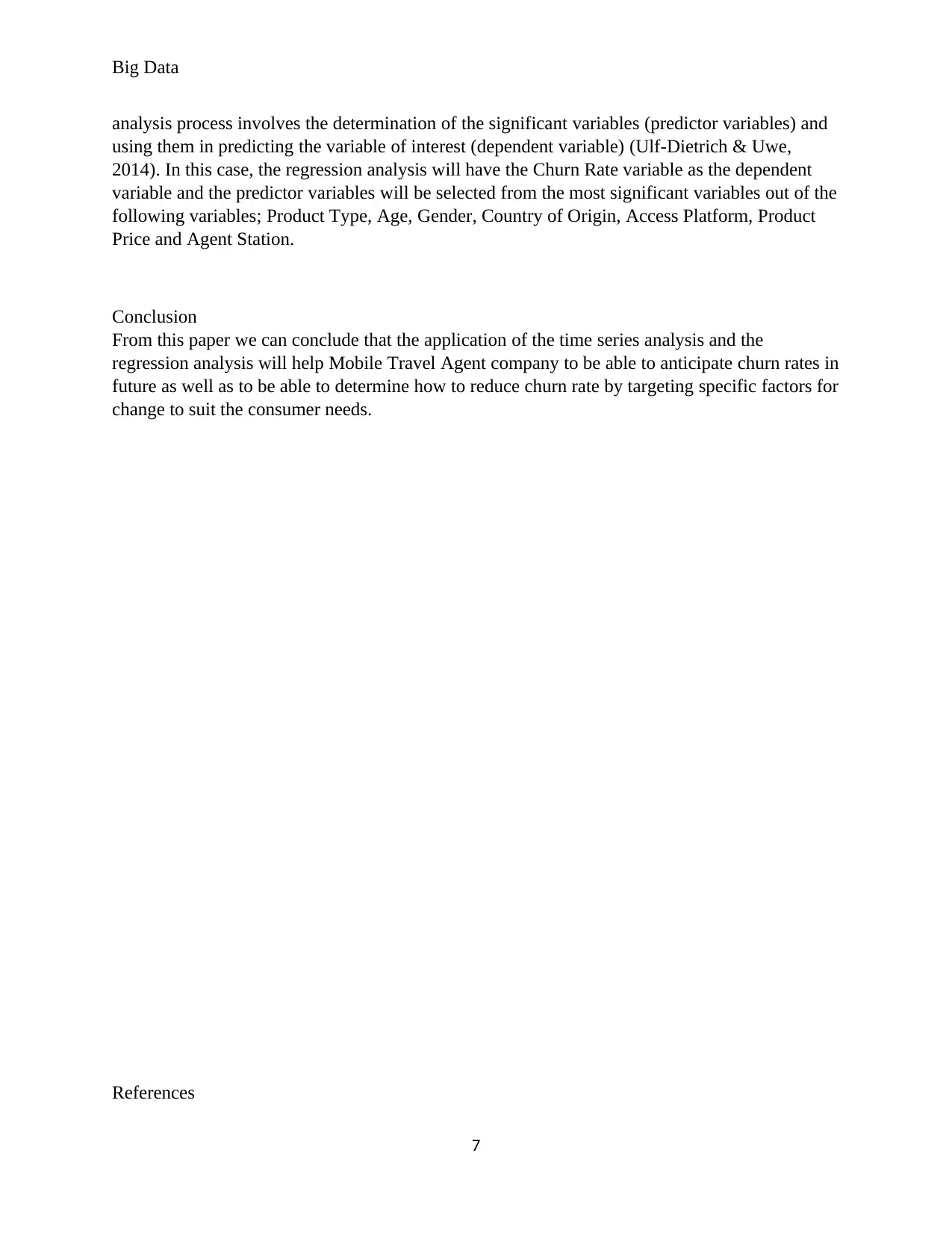
Big Data
analysis process involves the determination of the significant variables (predictor variables) and
using them in predicting the variable of interest (dependent variable) (Ulf-Dietrich & Uwe,
2014). In this case, the regression analysis will have the Churn Rate variable as the dependent
variable and the predictor variables will be selected from the most significant variables out of the
following variables; Product Type, Age, Gender, Country of Origin, Access Platform, Product
Price and Agent Station.
Conclusion
From this paper we can conclude that the application of the time series analysis and the
regression analysis will help Mobile Travel Agent company to be able to anticipate churn rates in
future as well as to be able to determine how to reduce churn rate by targeting specific factors for
change to suit the consumer needs.
References
7
analysis process involves the determination of the significant variables (predictor variables) and
using them in predicting the variable of interest (dependent variable) (Ulf-Dietrich & Uwe,
2014). In this case, the regression analysis will have the Churn Rate variable as the dependent
variable and the predictor variables will be selected from the most significant variables out of the
following variables; Product Type, Age, Gender, Country of Origin, Access Platform, Product
Price and Agent Station.
Conclusion
From this paper we can conclude that the application of the time series analysis and the
regression analysis will help Mobile Travel Agent company to be able to anticipate churn rates in
future as well as to be able to determine how to reduce churn rate by targeting specific factors for
change to suit the consumer needs.
References
7
Paraphrase This Document
Need a fresh take? Get an instant paraphrase of this document with our AI Paraphraser
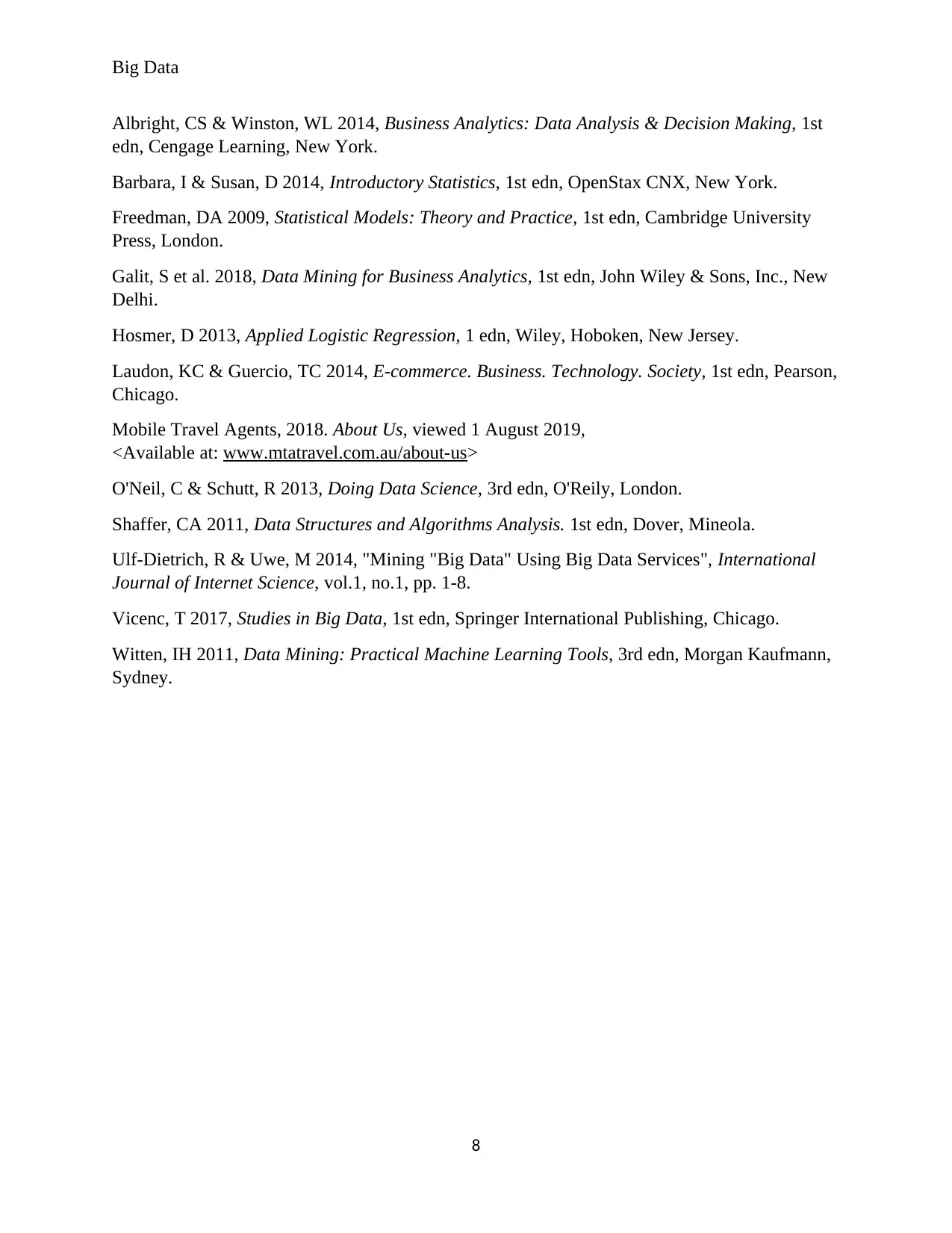
Big Data
Albright, CS & Winston, WL 2014, Business Analytics: Data Analysis & Decision Making, 1st
edn, Cengage Learning, New York.
Barbara, I & Susan, D 2014, Introductory Statistics, 1st edn, OpenStax CNX, New York.
Freedman, DA 2009, Statistical Models: Theory and Practice, 1st edn, Cambridge University
Press, London.
Galit, S et al. 2018, Data Mining for Business Analytics, 1st edn, John Wiley & Sons, Inc., New
Delhi.
Hosmer, D 2013, Applied Logistic Regression, 1 edn, Wiley, Hoboken, New Jersey.
Laudon, KC & Guercio, TC 2014, E-commerce. Business. Technology. Society, 1st edn, Pearson,
Chicago.
Mobile Travel Agents, 2018. About Us, viewed 1 August 2019,
<Available at: www.mtatravel.com.au/about-us>
O'Neil, C & Schutt, R 2013, Doing Data Science, 3rd edn, O'Reily, London.
Shaffer, CA 2011, Data Structures and Algorithms Analysis. 1st edn, Dover, Mineola.
Ulf-Dietrich, R & Uwe, M 2014, "Mining "Big Data" Using Big Data Services", International
Journal of Internet Science, vol.1, no.1, pp. 1-8.
Vicenc, T 2017, Studies in Big Data, 1st edn, Springer International Publishing, Chicago.
Witten, IH 2011, Data Mining: Practical Machine Learning Tools, 3rd edn, Morgan Kaufmann,
Sydney.
8
Albright, CS & Winston, WL 2014, Business Analytics: Data Analysis & Decision Making, 1st
edn, Cengage Learning, New York.
Barbara, I & Susan, D 2014, Introductory Statistics, 1st edn, OpenStax CNX, New York.
Freedman, DA 2009, Statistical Models: Theory and Practice, 1st edn, Cambridge University
Press, London.
Galit, S et al. 2018, Data Mining for Business Analytics, 1st edn, John Wiley & Sons, Inc., New
Delhi.
Hosmer, D 2013, Applied Logistic Regression, 1 edn, Wiley, Hoboken, New Jersey.
Laudon, KC & Guercio, TC 2014, E-commerce. Business. Technology. Society, 1st edn, Pearson,
Chicago.
Mobile Travel Agents, 2018. About Us, viewed 1 August 2019,
<Available at: www.mtatravel.com.au/about-us>
O'Neil, C & Schutt, R 2013, Doing Data Science, 3rd edn, O'Reily, London.
Shaffer, CA 2011, Data Structures and Algorithms Analysis. 1st edn, Dover, Mineola.
Ulf-Dietrich, R & Uwe, M 2014, "Mining "Big Data" Using Big Data Services", International
Journal of Internet Science, vol.1, no.1, pp. 1-8.
Vicenc, T 2017, Studies in Big Data, 1st edn, Springer International Publishing, Chicago.
Witten, IH 2011, Data Mining: Practical Machine Learning Tools, 3rd edn, Morgan Kaufmann,
Sydney.
8
1 out of 8
Related Documents
Your All-in-One AI-Powered Toolkit for Academic Success.
+13062052269
info@desklib.com
Available 24*7 on WhatsApp / Email
![[object Object]](/_next/static/media/star-bottom.7253800d.svg)
Unlock your academic potential
Copyright © 2020–2025 A2Z Services. All Rights Reserved. Developed and managed by ZUCOL.





